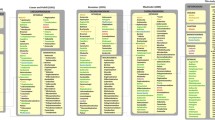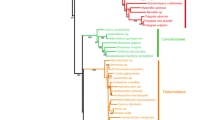Abstract
Orphanodendron is a taxonomically and geographically isolated South American genus of two species. When first described by Barneby and Grimes in 1990, the genus was placed in Leguminosae subfamily Caesalpinioideae, but that placement was doubted and the name Orphanodendron (Gr. orphanos, orphan + dendron, tree) was chosen to reflect the uncertain subfamilial relationship of the genus. In this study, nucleotide sequence data from five Orphanodendron specimens were added to 662 other, previously sampled, Leguminosae taxa representing all three currently recognized subfamilies (Caesalpinioideae, Mimosoideae and Papilionoideae) in a matK maximum parsimony analysis that resolved Orphanodendron as a member of the genistoid s.l. clade of subfamily Papilionoideae. Two additional Bayesian phylogenetic analyses with reduced taxon sampling of plastid (matK combined with trnL-F) and nuclear (ITS) loci strongly support the monophyly of Orphanodendron and unambiguously establish Orphanodendron as a member of the genistoid sensu lato clade. Although our plastid phylogenetic analysis finds relatively low support for a sister-group relationship with the African genus Camoensia, the nuclear-encoded ITS resolves Orphanodendron as sister to the Bowdichia clade with strong support and Camoensia as sister to other core genistoids. The phylogenetic resolution of Orphanodendron as a member of the genistoid s.l. legumes based on nuclear and plastid sequences will undoubtedly advance future evolutionary investigations of this Colombian endemic tropical tree genus.
Resumen
Orphanodendron es un género taxonómicamente y geográficamente aislado de Sur América. Cuando se describió por primera por Barneby y Grimes en 1990, el género, fue ubicado dentro de las Leguminosae subfamilia Caesalpinioideae, pero su posición fue incierta y el nombre Orphanodendron (del griego orphanos, huérfano + dendron, árbol) fue elegido para reflejar la afinidad incierta relación del género dentro de la subfamilia. En este estudio, datos de la secuencia nucleotidica de cinco especímenes de Orphanodendron fueron adicionados a otros 662 taxa de leguminosas previamente muestreados que representan las tres subfamilias actualmente reconocidas (Caesalpinioideae, Mimosoideae y Papilionoideae) en un análisis de máxima parsimonia en matK que resolvió a Orphanodendron como un miembro del clado genistoide s.l. de la subfamilia Papilionoideae. Dos análisis filogenéticos Bayesiano adicionales con un reducido número de taxones muestreados por loci de plastidio (matK combinado con trnL-F) y nuclear (ITS) soportaron fuertemente la monofila de Orphanodendron y una estabilidad sin ambigüedades de Orphanodendron como miembro del clado genistoides sensu lato. Aunque nuestro análisis filogenético del plastidio encontró un soporte relativamente bajo para una relación de grupo–hermano con el género africano Camoensia, la decodificación nuclear ITS resolvió a Orphanodendron como hermano del clado Bowdichia con un soporte fuerte y a Camoensia como hermano para otro core genistoide. La resolución filogenética basada en plastídio y núcleo de Orphanodendron como miembro las leguminosas genistoides s.l. indudablemente será un avance para las futuras investigaciones evolutivas de este género de árbol tropical endémico en Colombia.


Similar content being viewed by others
Literature cited
Barneby, R. C. & J. W. Grimes. 1990. Orphanodendron, a new genus of caesalpinioid Leguminosae from northwestern Colombia. Brittonia 42: 249–253.
Bentham, G. 1865. Leguminosae. In: G. Bentham & J. D. Hooker. Genera Plantarum 1(2): 434 –600.
Bruneau, A., M. Mercure, G. P. Lewis & P. S. Herendeen. 2008. Phylogenetic patterns and diversification in the caesalpinioid legumes. Botany 86: 697–718.
Cardoso, D., L. P. de Queiroz, R. T. Pennington, H. C. de Lima, É. Fonty, M. F. Wojciechowski & M. Lavin. 2012. Revisiting the phylogeny of papilionoid legumes: New insights from comprehensively sampled early-branching lineages. American Journal of Botany 99: 1991–2013.
Castellanos, C., G. P. Lewis, H. Banks, R. Steeves & A. Bruneau. 2015. Orphanodendron grandiflorum, una nueva especie de leguminosa (Leguminosae: Papilionoideae) de los andes de Colombia. Brittonia 67: 37–42.
–––––––– & G. P. Lewis. 2012. Leguminosas colombianas en el Real Jardín Botánico Kew, Reino Unido. Revista de la Academia Colombiana de Ciencias Exactas Físicas y Naturales. 36 (139): 149–200.
Chiou, M-J., Y. D. Wang, C. M. Kuo, J. C. Chen & J. Y. Chen. 2007. Functional analysis of Mitogen-Activated Protein Kinase-3 (MAPK3) and its regulation of the promoter region in zebrafish. DNA and Cell Biology 26: 781–790.
Cowan, R.S. 1981. Tribe Swartzieae. Pp. 209–211. In: R. M. Polhill & P. H. Raven (eds.), Advances in Legume Systematics, Part 1. Royal Botanic Gardens, Kew, U.K.
Crisp, M. D., S. Gilmore & B.-E. Van Wyk. 2000. Molecular phylogeny of the genistoid tribes of papilionoid legumes. Pp. 249–276. In: P. S. Herendeen & A. Bruneau (eds.), Advances in Legume Systematics, Part 9. Royal Botanic Gardens, Kew.
Doyle, J. J. & J. L. Doyle. 1987. A rapid DNA isolation procedure for small quantities of fresh leaf tissue. Phytochemical Bulletin 19: 11–15.
Hall, T. A. 1999. BioEdit: A user-friendly biological sequence alignment editor and analysis program for Windows 95/98/NT. Nucleic Acids Symposium Series 41: 95–98.
Hutchinson, J. 1964. The genera of flowering plants, Angiospermae, Vol. 1. Clarendon Press, Oxford.
Lavin, M., M. Thulin, J.-N. Labat & R. T. Pennington 2000. Africa, the odd man out: Molecular biogeographic studies of dalbergioid legumes (Fabaceae): suggest otherwise. Systematic Botany 25: 449–467.
Lewis, G. 2005. Tribe Caesalpinieae. Pp. 127–159. In: G. Lewis, B. Schrire, B. Mackinder & M. Lock (eds.), Legumes of the world. Royal Botanic Gardens, Kew.
López-Camacho, R., I. Montero & N. R. Salinas. 2007. Tirateté Orphanodendron bernalii. Pp. 214–217. In: D. Cárdenas L & N. R. Salinas (eds.). Libro rojo de plantas de Colombia, Vol. 4, Especies maderables amenazadas, Primera parte, Serie Libros rojos de especies amenazadas de Colombia. Instituto Amazónico de Investigaciones Científicas SINCHI —Ministerio de Ambiente y Desarrollo Territorial, Bogotá.
LPWG. 2013. Legume phylogeny and classification in the 21st century: Progress, prospects and lessons for other species-rich clades. Taxon 62: 217–248.
Manzanilla, V. & A. Bruneau. 2012. Phylogeny reconstruction in the Caesalpinieae grade (Leguminosae) based on duplicated copies of the sucrose synthase gene and plastid markers. Molecular Phylogenetics and Evolution, 65: 149–162.
Miller, M.A., W. Pfeiffer & T. Schwartz. 2010. Creating the CIPRES Science Gateway for inference of large phylogenetic trees. Pp. 45–52. In: Gateway Computing Environments Workshop (GCE 2010), New Orleans.
Nylander, J. 2004. MrModeltest v2. Program distributed by the author. Evolutionary Biology Centre, Uppsala University. (Downloadable from: https://github.com/nylander/MrModeltest2)
Pennington, R. T., B. B. Klitgaard, H. Ireland & M. Lavin. 2000. New insights into floral evolution of basal Papilionoideae from molecular phylogenies. Pp. 233–248. In: P. S. Herendeen & A. Bruneau (eds.), Advances in Legume Systematics, Part 9. Royal Botanic Gardens, Kew.
Polhill, R. M. 1981. Sophoreae. Pp. 213–230. In: R. M. Polhill and P. H. Raven (eds.), Advances in Legume Systematics, Part 1. Royal Botanic Gardens, Kew.
––––––––. 1994. Classification of the Leguminosae and complete synopsis of legume genera, Pp. XXXV–XLVIII. In: F. A. Bisby, J. Buckingham & J. B. Harborne (eds.), Phytochemical Dictionary of the Leguminosae. Chapman & Hall, Cambridge.
–––––––– & J. E. Vidal. 1981. Tribe Caesalpinieae. Pp. 81–95. In: R. M. Polhill & P. H. Raven (eds.), Advances in Legume Systematics, Part 1. Royal Botanic Gardens, Kew. U.K.
Ramos, G., H. C. Lima, G. Prenner, L. P. Queiroz, C. E. Zartman & D. Cardoso. 2016. Molecular systematics of the Amazonian genus Aldina, a phylogenetically enigmatic ectomycorrhizal lineage of papilionoid legumes. Molecular Phylogenetics and Evolution, 97: 11–18.
Rohland, N. & D. Reich. 2012. Cost-effective high-throughput DNA sequencing libraries. Genome Research 22: 939–946.
Ronquist, F. & J. P. Huelsenbeck. 2003. MrBayes 3: Bayesian phylogenetic inference under mixed models. Bioinformatics 19: 1572–1574.
Simon, M. F., R. Grether, L. P. de Queiroz, C. Skema, R. T. Pennington & C. E. Hughes. 2009. Recent assembly of the Cerrado, a Neotropical plant diversity hotspot, by in situ evolution of adaptations to fire. Proceedings of the National Academy of Sciences U.S.A. 106: 20359–20364.
Stöver, B. C. & K. F. Müller. 2010. TreeGraph 2: Combining and visualizing evidence from different phylogenetic analyses. BMC Bioinformatics 11: 1–9.
Taberlet, P., L. Gielly, G. Pautou & J. Bouvet. 1991. Universal primers for amplification of three non-coding regions of chloroplast DNA. Plant Molecular Biology 17: 1105–1109.
Thompson, J. D., D. G. Higgins & T. J. Gibson. 1994. CLUSTAL W: Improving the sensitivity of progressive multiple sequence alignment through sequence weighting, position-specific gap penalties and weight matrix choice. Nucleic Acids Research 22: 4673–4680.
Vaidya, G., D. J. Lohman & R. Meier. 2011. Sequence Matrix: Concatenation software for the fast assembly of multigene datasets with character set and codon information. Cladistics 27: 171–180.
Van Wyk, B. E. 2003. The value of chemosystematics in clarifying relationships in the genistoid tribes of papilionoid legumes. Biochemical Systematics and Ecology 31: 875–884.
Waterman, P. G. & D. F. Faulkner. 1982. Quinolizidine/indolizidine alkaloids from the seed of Camoensia brevicalyx. Phytochemistry 21: 215–218.
Wink, M. & G. I. A. Mohamed. 2003. Evolution of chemical defense traits in the Leguminosae: Mapping of distribution patterns of secondary metabolites on a molecular phylogeny inferred from nucleotide sequences of the rbcL gene. Biochemical Systematics and Ecology 31: 897–917.
Wojciechowski, M. F., M. Lavin & M. J. Sanderson. 2004. A phylogeny of legumes (Leguminosae) based on analysis of the plastid matK gene resolves many well-supported subclades within the family. American Journal of Botany 91: 1846–1862.
Yakovlev, G. P. 1972. A contribution to the system of the order Fabales Nakai (Leguminales Jones). Botanicheskii Zhurnal 57: 585–595.
Acknowledgments
This research was partially financed by Santo Tomás University-Villavicencio, through the administrative act 094: “discovery of a new plant species for the flora of Colombia” led by the first author. The molecular analyses were financed by a Natural Sciences and Engineering Research Council of Canada grant to AB. We thank the Kew herbarium (K) for permission to reproduce the image of an isotype of Orphanodendron bernalii. Thanks to William Ariza (for photo 2B), Álvaro Cogollo who kindly provided information and specimens of Orphanodendron, and Alexander Fernandez Rodriguez – USTA Villavicencio, for his review of an early draft of the paper. Special thanks are given to Domingos Cardoso and Matt Lavin for their thoughtful suggestions towards improving the manuscript.
Author information
Authors and Affiliations
Corresponding author
Electronic supplementary material
Below is the link to the electronic supplementary material.
Suppl. Material 1
Maximum parsimony tree comprising 3 accessions of Orphanodendron bernalii and 2 accessions of Orphanodendron grandiflorum together with 662 Leguminosae taxa comprising all three subfamilies (Caesalpinioideae, Mimosoideae, and Papilionoideae), as well as 7 outgroup taxa from Polygalaceae, Rosaceae, Surianaceae, and Quillajaceae. (JPG 165 kb)
Rights and permissions
About this article
Cite this article
Castellanos, C., Steeves, R., Lewis, G.P. et al. A settled sub-family for the orphan tree: The phylogenetic position of the endemic Colombian genus Orphanodendron in the Leguminosae. Brittonia 69, 62–70 (2017). https://doi.org/10.1007/s12228-016-9451-3
Published:
Issue Date:
DOI: https://doi.org/10.1007/s12228-016-9451-3




